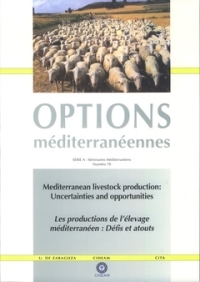| Article précédent | p. 423-429 |
Dans quel système de contrôle sanitaire est consommée la viande bovine au Liban : cas du Grand Beyrouth
La municipalité de Beyrouth s'inquiète de la qualité d'hygiène et de salubrité de la viande produite au niveau des abattoirs et des marchés de gros de la région de Sabraa. Il se pose ainsi un problème majeur de santé publique, même si pour l'instant aucune épidémie n'a été enregistrée. Nous avons choisi de focaliser notre analyse sur le Grand Beyrouth, la zone la plus pertinente eu égard à notre connaissance de la ville de Beyrouth (municipalité), qui a fait l'objet d'une thèse de Master of Science. La filière viande bovine au Liban est influencée par les mouvements de la croissance urbaine, de la mondialisation. Elle s'organise et se restructure pour répondre à un nouvel environnement socioéconomique. La taille limitée du marché interne ainsi que la politique d'ouverture de son économie ont rendu le marché libanais de la viande plus accessible à la concurrence. D'où l'intérêt d'intégrer la démarche qualité comme un moyen de différenciation des entreprises pour protéger la santé publique et, partant, faciliter la commercialisation de la viande. La fragmentation de l'industrie de la viande, caractérisée par une très grande diversité d'acteurs en interaction dans un petit espace et par sa forme artisanale, sont des éléments explicatifs des faibles performances. Aussi l'insuffisance d'infrastructures et de moyens techniques de transformation, l'absence d'un contrôle de qualité sérieux, le conditionnement manuel, ont entraîné une diminution de la compétitivité du secteur. La structure du marché et le comportement des acteurs ont également conditionné l'environnement sanitaire de la viande. Cette analyse suit la logique de l'approche filière, notamment en traitant toutes les étapes, de l'importation jusqu'à la consommation finale, afin d'apprécier la structure, le comportement des acteurs, ainsi que les opportunités et les contraintes que présente l'environnement pour la qualité sanitaire. Nous avons essayé de situer les moments et les parties des risques sanitaires tout en sachant que ces derniers, selon la littérature, sont présents à tous les niveaux.
The municipality of Beirut is concerned by the health and hygiene quality of meat produced from the abattoirs and wholesale markets of the region of Sabraa. Thus, a major problem of public health arises, even though at present no epidemics have been recorded. We have chosen to focus our analysis on Greater Beirut, the most pertinent area for our study of the city of Beirut (municipality) that has been the object of a Master of Science thesis. The beef sector in the Lebanon is influenced by urban sprawl and globalisation. It is organised and restructured in order to respond to a new socio-economic environment. The limited size of the domestic market as well as the economic liberalisation policy has made the Lebanese meat market more accessible to competition. Hence the interest in integrating the quality system as a means by which to differentiate the firms in order to protect public health and consequently, to facilitate the marketing of meat. The fragmentation of the meat industry, characterised by a very wide diversity of stakeholders interacting in a small area and as well as their artisanal nature, are elements that explain such a weak performance. Likewise, insufficient infrastructures and technical processing equipment, the absence of a rigorous quality control, manual packing, have led to a decrease in competitivity of the sector. The market structure as well as the behaviour of the stakeholders have likewise conditioned the sanitary environment of the meat. This analysis follows the logic of a study of all stages of the production sector, from imports to final consumption, to examine the structure, the behaviour of the stakeholders and the opportunities and constraints that the environment presents for health quality. We have attempted to situate the time and places where health hazards may occur, whilst being aware that the latter, according to the literature, may occur at all levels.
- [ Afficher ]
- [ Télécharger ]
- [ Exporter la citation ]
Vous pouvez télécharger la citation au format :
- [ Imprimer ]
-
Mots-clés
CIRCUIT DE COMMERCIALISATION, HYGIENE, INFRASTRUCTURE, LIBAN, MARCHE, QUALITE, SANTE PUBLIQUE, VIANDE BOVINECiter cet article
Zitouni I. Dans quel système de contrôle sanitaire est consommée la viande bovine au Liban : cas du Grand Beyrouth. In : Olaizola A. (ed.), Boutonnet J.P. (ed.), Bernués A. (ed.). Mediterranean livestock production: uncertainties and opportunities . Zaragoza : CIHEAM / CITA / CITA, 2008. p. 423-429. (Options Méditerranéennes : Série A. Séminaires Méditerranéens; n. 78). 2. Seminar of the Scientific-Professional Network on Mediterranean Livestock Farming (RME), 2006/05/18-20, Zaragoza, (Spain). http://om.ciheam.org/om/pdf/a78/00800298.pdf



